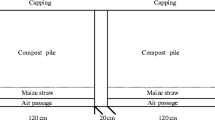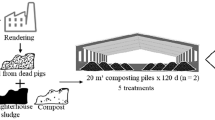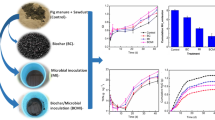Abstract
There remains an urgent need for low-cost and effective additives to allow the simultaneous passivation of trace elements and removal of antibiotics during composting. Here, we investigated the effects of the addition of additives, white-rot fungi (WF), wood vinegar (PA), biochar (BC), and a mixture of the three (OAC), on trace element passivation, antibiotic degradation, composting enhancement, and compost quality improvement during the aerobic composting of pig manure. We found that the passivation rate of Cu and Zn, in addition to the removal efficiency of sulfadiazine (SDZ) and norfloxacin (NFC), was enhanced with WF, PA, BC, and OAC treatment in comparison with the control. Moreover, the co-addition of BC, PA, and WF (OAC) allowed more efficient passivation of Cu and Zn (88.31% and 91.38%, respectively), better elimination of antibiotics (SDZ: 100%; NFC: 90.32%), and increased compost quality as compared with the addition of each component alone. Furthermore, the thermophilic stage duration and the germination index (GI) were also enhanced. In conclusion, the use of pyrolytic by-products and white-rot fungi as additives in composting is a promising low-cost, efficient detoxification method to improve compost quality and reduce environmental risks.



Similar content being viewed by others
Data availability
The datasets generated and/or analyzed during the current study are available from the corresponding author upon reasonable request.
References
Chen H, Zheng C, Qiao Y, Du S, Li W, Zhang X et al (2021) Long-term organic and inorganic fertilization alters the diazotrophic abundance, community structure, and co-occurrence patterns in a vertisol. Sci Total Environ 766:142441. https://doi.org/10.1016/j.scitotenv.2020.142441
Atieno M, Herrmann L, Huong Thu N, HoanThi P, Nghia Khoi N, Srean P et al (2020) Assessment of biofertilizer use for sustainable agriculture in the Great Mekong Region. J Environ Manage 275:111300. https://doi.org/10.1016/j.jenvman.2020.111300
Wu L, Jiang Y, Zhao F, He X, Liu H, Yu K (2020) Increased organic fertilizer application and reduced chemical fertilizer application affect the soil properties and bacterial communities of grape rhizosphere soil. Sci Rep 10:9568. https://doi.org/10.1038/s41598-020-66648-9
Cai Z, Wang B, Zhang L, Wen S, Xu M, Misselbrook TH et al (2021) Striking a balance between N sources: Mitigating soil acidification and accumulation of phosphorous and heavy metals from manure. Sci Total Environ 754:142189. https://doi.org/10.1016/j.scitotenv.2020.142189
Ho YB, Zakaria MP, Latif PA, Saari N (2013) Degradation of veterinary antibiotics and hormone during broiler manure composting. Bioresour Technol 131:476–484. https://doi.org/10.1016/j.biortech.2012.12.194
Kumar V, Pandita S, Sidhu GPS, Sharma A, Khanna K, Kaur P et al (2021) Copper bioavailability, uptake, toxicity and tolerance in plants: a comprehensive review. Chemosphere 262:127810. https://doi.org/10.1016/j.chemosphere.2020.127810
Zhao H, Wu L, Chai T, Zhang Y, Tan J, Ma S (2012) The effects of copper, manganese and zinc on plant growth and elemental accumulation in the manganese-hyperaccumulator Phytolacca americana. J Plant Physiol 169:1243–1252. https://doi.org/10.1016/j.jplph.2012.04.016
Angelova V, Ivanov K, Ivanova R (2004) Effect of chemical forms of lead, cadmium, and zinc in polluted soils on their uptake by tobacco. J Plant Nutr 27:757–773. https://doi.org/10.1081/pln-120030609
Deng W, Zhang A, Chen S, He X, Jin L, Yu X et al (2020) Heavy metals, antibiotics and nutrients affect the bacterial community and resistance genes in chicken manure composting and fertilized soil. J Environ Manage 257:109980. https://doi.org/10.1016/j.jenvman.2019.109980
Wang J, Ben W, Zhang Y, Yang M, Qiang Z (2015) Effects of thermophilic composting on oxytetracycline, sulfamethazine, and their corresponding resistance genes in swine manure. Environ Sci- Pro Imp 17:1654–1660. https://doi.org/10.1039/c5em00132c
Xie W, Yang X, Li Q, Wu L, Shen Q, Zhao F (2016) Changes in antibiotic concentrations and antibiotic resistome during commercial composting of animal manures. Environ Pollut 219:182–190. https://doi.org/10.1016/j.envpol.2016.10.044
Zhou H, Meng H, Zhao L, Shen Y, Hou Y, Cheng H et al (2018) Effect of biochar and humic acid on the copper, lead, and cadmium passivation during composting. Bioresour Technol 258:279–286. https://doi.org/10.1016/j.biortech.2018.02.086
Chen Z, Fu Q, Cao Y, Wen Q, Wu Y (2021) Effects of lime amendment on the organic substances changes, antibiotics removal, and heavy metals speciation transformation during swine manure composting. Chemosphere 262:128342. https://doi.org/10.1016/j.chemosphere.2020.128342
Hao J, Wei Z, Wei D, Ahmed Mohamed T, Yu H, Xie X et al (2019) Roles of adding biochar and montmorillonite alone on reducing the bioavailability of heavy metals during chicken manure composting. Bioresour Technol 294:122199. https://doi.org/10.1016/j.biortech.2019.122199
Peng Y, Azeem M, Li R, Xing L, Li Y, Zhang Y et al (2022) Zirconium hydroxide nanoparticle encapsulated magnetic biochar composite derived from rice residue: Application for As(III) and As(V) polluted water purification. J Hazard Mater 423:127081. https://doi.org/10.1016/j.jhazmat.2021.127081
Fang Y, Ali A, Gao Y, Zhao P, Li R, Li X et al (2022) Preparation and characterization of MgO hybrid biochar and its mechanism for high efficient recovery of phosphorus from aqueous media. Biochar 4:40. https://doi.org/10.1007/s42773-022-00171-0
Wang J, Pan J, Ma X, Li S, Chen X, Liu T et al (2022) Solid digestate biochar amendment on pig manure composting: nitrogen cycle and balance. Bioresour Technol 349:126848. https://doi.org/10.1016/j.biortech.2022.126848
Chen Y, Liu Y, Li Y, Wu Y, Chen Y, Zeng G et al (2017) Influence of biochar on heavy metals and microbial community during composting of river sediment with agricultural wastes. Bioresour Technol 243:347–355. https://doi.org/10.1016/j.biortech.2017.06.100
Zhang F, Yang H, Guo D, Zhang S, Chen H, Shao J (2019) Effects of biomass pyrolysis derived wood vinegar (WVG) on extracellular polymeric substances and performances of activated sludge. Bioresour Technol 274:25–32. https://doi.org/10.1016/j.biortech.2018.11.064
Quan X, Shan J, Xing Y, Peng C, Wang H, Ju Y et al (2021) New horizons in the application of a neglected biomass pyrolysis byproduct: a marked simultaneous decrease in ammonia and carbon dioxide emissions. J Clean Prod 297:126626. https://doi.org/10.1016/j.jclepro.2021.126626
Hua D, Fan Q, Zhao Y, Xu H, Chen L, Si H et al (2020) Continuous anaerobic digestion of wood vinegar wastewater from pyrolysis: microbial diversity and functional genes prediction. Front Bioeng Biotechnol 8:923. https://doi.org/10.3389/fbioe.2020.00923
Zhang F, Shao J, Yang H, Guo D, Chen Z, Zhang S et al (2019) Effects of biomass pyrolysis derived wood vinegar on microbial activity and communities of activated sludge. Bioresour Technol 279:252–261. https://doi.org/10.1016/j.biortech.2019.01.133
Xu C, Yuan Q, Qin C, Xie G, He T, Song N (2020) Effect of wood vinegar on physicochemical properties and seeding capability of cow manure aerobic composting. Trans Chin Soc Agric Mach 51:353–360
Sun H, Feng Y, Xue L, Mandal S, Wang H, Shi W et al (2020) Responses of ammonia volatilization from rice paddy soil to application of wood vinegar alone or combined with biochar. Chemosphere 242:125247. https://doi.org/10.1016/j.chemosphere.2019.125247
Wang C, Wu M, Peng C, Yan F, Jia Y, Li X et al (2022) Bacterial dynamics and functions driven by a novel microbial agent to promote kitchen waste composting and reduce environmental burden. J Clean Prod 337:130491. https://doi.org/10.1016/j.jclepro.2022.130491
Wang C, Jia Y, Li J, Li P, Wang Y, Yan F et al (2023) Influence of microbial augmentation on contaminated manure composting: metal immobilization, matter transformation, and bacterial response. J Hazard Mater 441:129762. https://doi.org/10.1016/j.jhazmat.2022.129762
Li MX, He XS, Tang J, Li X, Zhao R, Tao Y et al (2021) Influence of moisture content on chicken manure stabilization during microbial agent-enhanced composting. Chemosphere 264:128549. https://doi.org/10.1016/j.chemosphere.2020.128549
Zhang C, Xu Y, Zhao M, Rong H, Zhang K (2018) Influence of inoculating white-rot fungi on organic matter transformations and mobility of heavy metals in sewage sludge based composting. J Hazard Mater 344:163–168. https://doi.org/10.1016/j.jhazmat.2017.10.017
Tortella G, Duran N, Rubilar O, Parada M, Diez M (2015) Are white-rot fungi a real biotechnological option for the improvement of environmental health? Crit Rev Biotechnol 35:165–172. https://doi.org/10.3109/07388551.2013.823597
Stella T, Covino S, Cvancarova M, Filipova A, Petruccioli M, D’Annibale A et al (2017) Bioremediation of long-term PCB-contaminated soil by white-rot fungi. J Hazard Mater 324:701–710. https://doi.org/10.1016/j.jhazmat.2016.11.044
Tu Z, Ren X, Zhao J, Awasthi S, Wang Q, Awasthi M et al (2019) Synergistic effects of biochar/microbial inoculation on the enhancement of pig manure composting. Biochar 1:127–137. https://doi.org/10.1007/s42773-019-00003-8
Kan T, Strezov V, Evans T (2016) Lignocellulosic biomass pyrolysis: a review of product properties and effects of pyrolysis parameters. Renew Sust Energ Rev 57:1126–1140. https://doi.org/10.1016/j.rser.2015.12.185
Wang X, Zhang W, Gu J, Gao H, Qin Q (2016) Effects of different bulking agents on the maturity, enzymatic activity, and microbial community functional diversity of kitchen waste compost. Environ Technol 37:2555–2563. https://doi.org/10.1080/09593330.2016.1155650
Horváth M, Boková V, Heltai G, Flórián K, Fekete I (2010) Study of application of BCR sequential extraction procedure for fractionation of heavy metal content of soils, sediments, and gravitation dusts. Toxicol Environ Chem 92:429–441. https://doi.org/10.1080/02772240903036147
Garcia-Galan MJ, Rodriguez-Rodriguez CE, Vicent T, Caminal G, Diaz-Cruz MS, Barcelo D (2011) Biodegradation of sulfamethazine by Trametes versicolor: removal from sewage sludge and identification of intermediate products by UPLC-QqTOF-MS. Sci Total Environ 409:5505–5512. https://doi.org/10.1016/j.scitotenv.2011.08.022
Huang Y, Cheng M, Li W, Wu L, Chen Y, Luo Y et al (2013) Simultaneous extraction of four classes of antibiotics in soil, manure and sewage sludge and analysis by liquid chromatography-tandem mass spectrometry with the isotope-labelled internal standard method. Anal Methods 5:3721–3731. https://doi.org/10.1039/C3AY40220G
Zhang M, He LY, Liu YS, Zhao JL, Liu WR, Zhang JN et al (2019) Fate of veterinary antibiotics during animal manure composting. Sci Total Environ 650:1363–1370. https://doi.org/10.1016/j.scitotenv.2018.09.147
Govindaraju M, Sathasivam KV, Marimuthu K (2021) Waste to wealth: value recovery from bakery wastes. Sustainability 13:2835. https://doi.org/10.3390/su13052835
Wei L, Shutao W, Jin Z, Tong X (2014) Biochar influences the microbial community structure during tomato stalk composting with chicken manure. Bioresour Technol 154:148–154. https://doi.org/10.1016/j.biortech.2013.12.022
Chen Y, Chen Y, Li Y, Wu Y, Zeng Z, Xu R et al (2019) Changes of heavy metal fractions during co-composting of agricultural waste and river sediment with inoculation of Phanerochaete chrysosporium. J Hazard Mater 378:120757. https://doi.org/10.1016/j.jhazmat.2019.120757
Awasthi MK, Wang Q, Huang H, Ren X, Lahori AH, Mahar A et al (2016) Influence of zeolite and lime as additives on greenhouse gas emissions and maturity evolution during sewage sludge composting. Bioresour Technol 216:172–181. https://doi.org/10.1016/j.biortech.2016.05.065
Wei Y, Zhao Y, Shi M, Cao Z, Lu Q, Yang T et al (2018) Effect of organic acids production and bacterial community on the possible mechanism of phosphorus solubilization during composting with enriched phosphate-solubilizing bacteria inoculation. Bioresour Technol 247:190–199. https://doi.org/10.1016/j.biortech.2017.09.092
Li HH, Zhang T, Tsang DCW, Li GX (2020) Effects of external additives: biochar, bentonite, phosphate, on co-composting for swine manure and corn straw. Chemosphere 248:125927. https://doi.org/10.1016/j.chemosphere.2020.125927
Chen W, Liao X, Wu Y, Liang JB, Mi J, Huang J et al (2017) Effects of different types of biochar on methane and ammonia mitigation during layer manure composting. Waste Manage 61:506–515. https://doi.org/10.1016/j.wasman.2017.01.014
Huang GF, Wong JW, Wu QT, Nagar BB (2004) Effect of C/N on composting of pig manure with sawdust. Waste Manage 24:805–813. https://doi.org/10.1016/j.wasman.2004.03.011
Yuan J, Li Y, Chen S, Li D, Tang H, Chadwick D et al (2018) Effects of phosphogypsum, superphosphate, and dicyandiamide on gaseous emission and compost quality during sewage sludge composting. Bioresour Technol 270:368–376. https://doi.org/10.1016/j.biortech.2018.09.023
Singh J, Kalamdhad AS (2012) Concentration and speciation of heavy metals during water hyacinth composting. Bioresour Technol 124:169–179. https://doi.org/10.1016/j.biortech.2012.08.043
Lu XM, Lu PZ, Chen JJ, Zhang H, Fu J (2015) Effect of passivator on Cu form transformation in pig manure aerobic composting and application in soil. Environ Sci Pollut Res 22:14727–14737. https://doi.org/10.1007/s11356-015-4680-7
Sun S, Gao ZT, Li ZC, Li Y, Gao JL, Chen YJ et al (2020) Effect of wood vinegar on adsorption and desorption of four kinds of heavy (loid) metals adsorbents. Chinese J Anal Chem 48:e20013–e20020. https://doi.org/10.1016/s1872-2040(19)61217-x
Agegnehu G, Srivastava AK, Bird MI (2017) The role of biochar and biochar-compost in improving soil quality and crop performance: a review. Appl Soil Ecol 119:156–170. https://doi.org/10.1016/j.apsoil.2017.06.008
Liu W, Huo R, Xu J, Liang S, Li J, Zhao T et al (2017) Effects of biochar on nitrogen transformation and heavy metals in sludge composting. Bioresour Technol 235:43–49. https://doi.org/10.1016/j.biortech.2017.03.052
Chen Z, Wu Y, Wen Q, Bao H, Fu Q (2020) Insight into the effects of sulfamethoxazole and norfloxacin on nitrogen transformation functional genes during swine manure composting. Bioresour Technol 297:122463. https://doi.org/10.1016/j.biortech.2019.122463
Shi H, Wang XC, Li Q, Jiang S (2016) Degradation of typical antibiotics during human feces aerobic composting under different temperatures. Environ Sci Pollut Res 23:15076–15087. https://doi.org/10.1007/s11356-016-6664-7
Riaz L, Wang Q, Yang Q, Li X, Yuan W (2020) Potential of industrial composting and anaerobic digestion for the removal of antibiotics, antibiotic resistance genes and heavy metals from chicken manure. Sci Total Environ 718:137414. https://doi.org/10.1016/j.scitotenv.2020.137414
Khadra A, Ezzariai A, Merlina G, Capdeville MJ, Budzinski H, Hamdi H et al (2019) Fate of antibiotics present in a primary sludge of WWTP during their co-composting with palm wastes. Waste Manage 84:13–19. https://doi.org/10.1016/j.wasman.2018.11.009
Wang Y, Qiu L, Song Q, Wang S, Wang Y, Ge Y (2019) Root proteomics reveals the effects of wood vinegar on wheat growth and subsequent tolerance to drought stress. Int J Mol Sci 20:943. https://doi.org/10.3390/ijms20040943
Luo X, Wang Z, Meki K, Wang X, Liu B, Zheng H et al (2019) Effect of co-application of wood vinegar and biochar on seed germination and seedling growth. J Soil Sediment 19:3934–3944. https://doi.org/10.1007/s11368-019-02365-9
Lu X, Jiang J, He J, Sun K, Sun Y (2019) Effect of pyrolysis temperature on the characteristics of wood vinegar derived from Chinese fir waste: a comprehensive study on its growth regulation performance and mechanism. ACS Omega 4:19054–19062. https://doi.org/10.1021/acsomega.9b02240
Funding
This study is funded by the Scientific and Technological Project of Heilongjiang Province (2021ZXJ03B05), Heilongjiang Provincial Postdoctoral Science Foundation (LBH-Q17021), and Key Research and Development projects of Heilongjiang Province (GA21D009).
Author information
Authors and Affiliations
Contributions
Jinxia Fan: Writing, original draft; formal analysis; validation; investigation; visualization. Shuang Ai: Conceptualization, methodology, project administration. Ting Yin: Writing, review and editing; visualization; conceptualization; methodology. Hongqiong Zhang: Writing, review and editing; visualization; conceptualization; methodology. Dongxu Tao: Conceptualization, methodology. Siyu Wang: Conceptualization, methodology, data curation. Guoxiang Zheng: Conceptualization; methodology; writing, review and editing; supervision.
Corresponding author
Ethics declarations
Ethics approval and consent to participate
Not applicable.
Consent for publication
Not applicable.
Competing interests
The authors declare no competing interests.
Additional information
Publisher's Note
Springer Nature remains neutral with regard to jurisdictional claims in published maps and institutional affiliations.
Supplementary Information
Below is the link to the electronic supplementary material.
Rights and permissions
Springer Nature or its licensor (e.g. a society or other partner) holds exclusive rights to this article under a publishing agreement with the author(s) or other rightsholder(s); author self-archiving of the accepted manuscript version of this article is solely governed by the terms of such publishing agreement and applicable law.
About this article
Cite this article
Fan, J., Ai, S., Zheng, G. et al. Insight into effects of pyrolysis products and white-rot fungi on co-composting of pig manure and corn stalk. Biomass Conv. Bioref. (2023). https://doi.org/10.1007/s13399-023-03797-7
Received:
Revised:
Accepted:
Published:
DOI: https://doi.org/10.1007/s13399-023-03797-7




